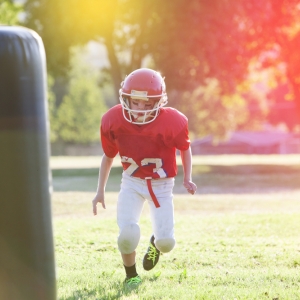Youth Football Training Tips

As important as high school and college football are for the development of young players, the foundation of winning football players is built at the youth football level. Before a young player ever suits up for a high school or college program — let alone at the professional level — the talents and habits that will make that player successful are first developed in Pee Wee football programs and other youth football leagues. It’s in these programs that players learn not only the fundamentals of the game, but also the principles of good sportsmanship and the practices that will keep them safe and healthy out on the gridiron.
For that reason, youth football coaches have an enormous responsibility to their players, one that’s bigger than even the highest-paid professional coach has. The Bill Belichicks of the world may write the fate of billion-dollar professional franchises in their playbooks, but their players already are grown men with a lifetime of football experience under their belts. The task of building them into professional athletes in the first place fell to their youth football coaches. However eager you might be as a youth football coach to mold your players into the superstars of tomorrow, you most likely don’t have all the same resources even a high school coach has. With that in mind, here are some youth football training tips you can use to help your team members on their way to becoming well-rounded players as well as people.
Focus on fundamentals. Probably the most important thing you can do as a coach is focus on teaching solid youth football fundamentals. You might show up on the first day with a 200-page playbook that you think will dominate the entire league, but your players probably don’t know the proper way to catch the football. If you assume your players already know how to do the basics — such as blocking, tackling and passing — you’re not only setting your team up for failure during the season, but you’re also setting your players up for failure later in their development.
Emphasize sportsmanship. Leadership is extremely important in football, and there’s no better way to lead than by example. Coaches who spout clichés about “building leaders” and “strengthening character” but encourage their players to take cheap shots at opponents or trash talk are neglecting one of the most important parts of being a coach. When players learn to respect their teammates and opponents on and off the field, they are much more likely to be the type of young people the world needs more of today. That behavior begins with a coach who respects players, treats them fairly, and models good behavior on the sidelines as well as during practice.
Keep everything in perspective. Every coach wants to win, but at the youth football level it’s important to step back and see the bigger picture once in a while. Although winning is great, in the end you don’t want that city league trophy to be the highlight of a player’s career. As long as players are learning the fundamentals of the game and building character as they play, it’s OK to lose every now and then. Youth football coaches who take a “win at all costs” mentality at the Pee Wee level can suck all the fun out of the game and discourage players from suiting up again the next season. Kids play football because they want to win and have fun, but a coach who screams at players for making mistakes or keeps some players on the bench all season can make even a perfect season feel miserable.
Run the right drills. Some football drills are coaching staples at the high school and college levels but aren’t appropriate for players at the youth football level. Here are a few youth football training drills that focus on developing fundamentals without overdoing it:
- Place a blocking pad on the ground and have two players wearing full pads straddle it, facing each other. Have players start in the read position and explode at each other at the whistle. This drill helps players become unafraid to make contact with each other in full pads.
- Have players stand in lines on the field with enough space between them to allow them to explode forward (or backward in the quarterback’s case). At the “one” count, players plant their feet. On “two,” players get into their position’s specific stance. On “three,” players explode forward (or backward) three steps. This drill should be repeated several times, with coaches moving around the field and correcting any players who are in the incorrect stances or explode too late.
Even though a youth football coach’s resources are far more limited than coaches at higher levels have, they still have an enormous responsibility to their players. There’s a lot more to coaching youth football than making sure you order the right youth football uniforms — you’re laying the foundation on which your players will build the rest of their football careers.

